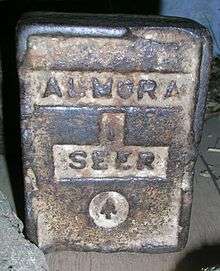Seer (unit)
A Seer (also sihr) is a traditional unit of mass and volume used in large parts of Asia prior to the middle of the 20th century. It remains in use only in a few countries such as Afghanistan and Iran, although in the latter it indicates a smaller unit of weight than the one used in India.
India
| British Indian units of mass | ||
|---|---|---|
In India, the seer (Government seer) was defined by the Standards of Weights and Measures Act (No. 89 of 1956, amended in 1960 and 1964) as being exactly equal to 1.25 kg (1.792 lb). However, there were many local variants of the seer in India.
| Bengal | 80 tolas of rice |
| South India | mass of 24 current rupees |
| Chennai (formerly Madras) | approx 25 lb (9.33 kg) |
| Juggerat | mass of 40 local rupees |
| Mumbai (formerly Bombay) | 28 lb (10.45 kg) called the Old Seer |
Oman, Nepal and Pakistan
In Aden (Oman), Nepal, and Pakistan a seer was approximately 0.93310 kg (2.057 lb) derived from the Government seer of British colonial days.
Afghanistan
In Afghanistan, it was a unit of mass, approximately 7.066 kg (15.58 lb).
Persia/Iran
In Persia (and later Iran), it was and remains in two units.
- The metric seer was 74.22 g (2.618 oz)
- The seer (sihr) was 160 g (5.64 oz)
The smaller weight is now part of the national weight system in Iran and is used on daily basis for small measures purchases of delicate food stuff and the choice produce.
Sri Lanka
In Sri Lanka, it was a measure of capacity, approximately 1.86 pint (1.024 litres)
See also
References
"Seer". Sizes, grades, units, scales, calendars, chronologies. Retrieved 2007-02-19. External link in |work= (help)
